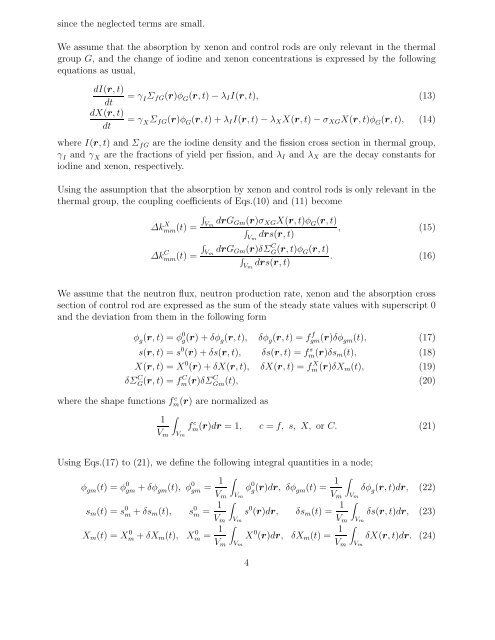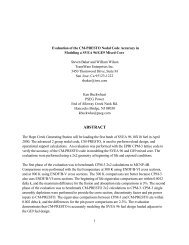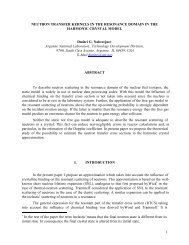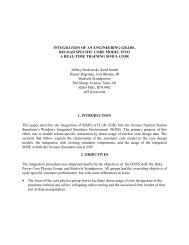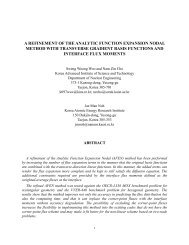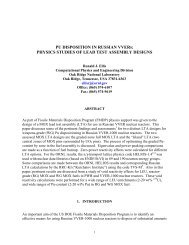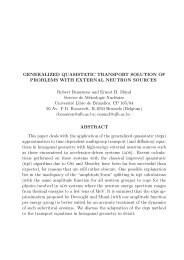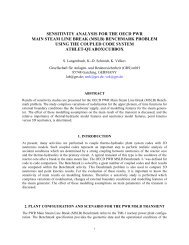K. Kobayashi and S. Tsumura
K. Kobayashi and S. Tsumura
K. Kobayashi and S. Tsumura
You also want an ePaper? Increase the reach of your titles
YUMPU automatically turns print PDFs into web optimized ePapers that Google loves.
since the neglected terms are small.<br />
We assume that the absorption by xenon <strong>and</strong> control rods are only relevant in the thermal<br />
group G, <strong>and</strong> the change of iodine <strong>and</strong> xenon concentrations is expressed by the following<br />
equations as usual,<br />
dI(r,t)<br />
dt = γIΣfG(r)φG(r,t) − λII(r,t), (13)<br />
dX(r,t)<br />
= γ<br />
dt<br />
XΣfG(r)φG(r,t)+λII(r,t) − λXX(r,t) − σXGX(r,t)φG(r,t), (14)<br />
where I(r,t) <strong>and</strong> ΣfG are the iodine density <strong>and</strong> the fission cross section in thermal group,<br />
γI <strong>and</strong> γX are the fractions of yield per fission, <strong>and</strong> λI <strong>and</strong> λX are the decay constants for<br />
iodine <strong>and</strong> xenon, respectively.<br />
Using the assumption that the absorption by xenon <strong>and</strong> control rods is only relevant in the<br />
thermal group, the coupling coefficients of Eqs.(10) <strong>and</strong> (11) become<br />
∆k X mm (t) =<br />
∆k C mm (t) =<br />
<br />
Vm drGGm(r)σXGX(r,t)φG(r,t) <br />
Vm drs(r,t)<br />
, (15)<br />
<br />
Vm drGGm(r)δΣ C G(r,t)φG(r,t) <br />
Vm drs(r,t)<br />
. (16)<br />
We assume that the neutron flux, neutron production rate, xenon <strong>and</strong> the absorption cross<br />
section of control rod are expressed as the sum of the steady state values with superscript 0<br />
<strong>and</strong> the deviation from them in the following form<br />
φg(r,t)=φ 0<br />
g(r)+δφg(r,t), δφg(r,t)=f f gm(r)δφgm(t), (17)<br />
s(r,t)=s 0 (r)+δs(r,t), δs(r,t)=f s m (r)δsm(t), (18)<br />
X(r,t)=X 0 (r)+δX(r,t), δX(r,t)=f X m (r)δXm(t), (19)<br />
δΣ C<br />
G (r,t)=f C m (r)δΣCGm<br />
(t), (20)<br />
where the shape functions f c m (r) are normalized as<br />
1<br />
Vm<br />
<br />
Vm<br />
f c m (r)dr =1, c = f, s, X, or C. (21)<br />
Using Eqs.(17) to (21), we define the following integral quantities in a node;<br />
φgm(t) =φ 0<br />
gm + δφgm(t), φ 0<br />
<br />
1<br />
gm = φ<br />
Vm Vm<br />
0<br />
g (r)dr, δφgm(t) = 1<br />
<br />
δφg(r,t)dr, (22)<br />
Vm Vm<br />
sm(t) =s 0 m + δsm(t), s 0 <br />
1<br />
m = s<br />
Vm Vm<br />
0 (r)dr, δsm(t) = 1<br />
<br />
δs(r,t)dr, (23)<br />
Vm Vm<br />
Xm(t) =X 0 m + δXm(t), X 0 m = 1<br />
<br />
X 0 (r)dr, δXm(t) = 1<br />
<br />
δX(r,t)dr. (24)<br />
Vm<br />
Vm<br />
4<br />
Vm<br />
Vm


